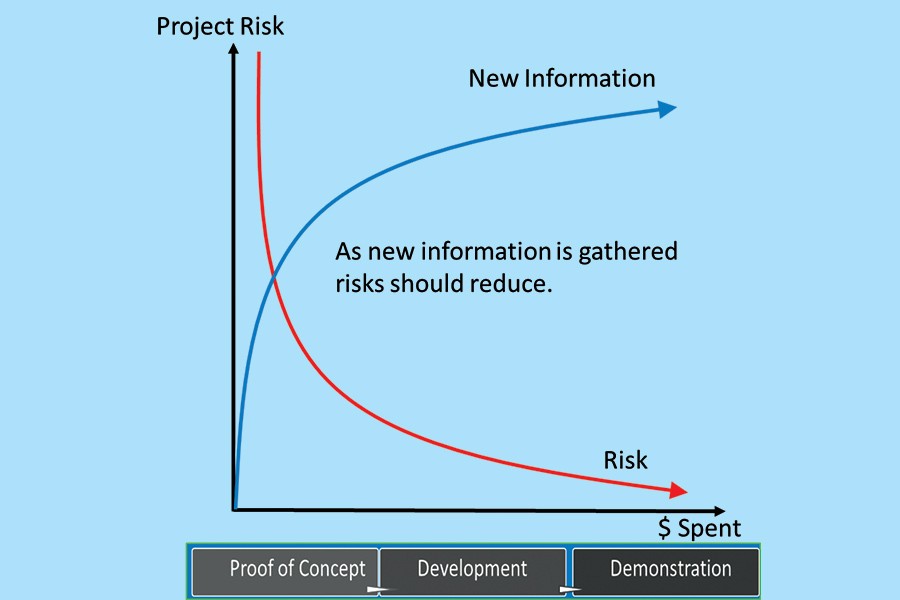Bangladesh's position in the RMG industry is based on its bountiful supply of cheap labour and the relatively simple technology needed to establish an RMG enterprise. Foreign investment has been important in the growth of the industry although local investment is playing its part. There is now considerable discussion on the need to establish a backward linkage industry to ensure the future sustainability of the RMG industry as fast fashion trends increasingly require short lead times.
Although the industry is well positioned, there is an intense competition in the global textile industry. Bangladesh cannot assume that low labour costs alone will ensure the future success of the industry. The industry and government need to plan for the evolution of the industry to meet the future needs of the global consumers and compete with new low-cost entrants to the market. An important component of this plan should be innovation.
The OECD estimates that as much as 50 per cent of economic growth in its member countries can be accounted for by innovation activity, and that this contribution will grow. Innovation has been demonstrated to drive productivity growth and the competitive advantage of businesses.
Innovation has until recently been regarded as the preserve of developed nations, but now emerging economies are generating disruptive product and process innovations that are achieving new levels of performance, at a competitive price, for a range of globally traded goods and services. If Bangladesh can combine its labour force strengths with new innovations, the industry can gain sustained levels of competitive advantage as the economy matures and the industry evolves.
Although successful innovation creates competitive advantage, investment in innovation is risky. According to an Accenture report published in 2013, "despite increased business investment in innovation, only 18 per cent of executives believe their company's innovation efforts deliver a competitive advantage." Therefore, a careful risk management approach needs to be taken. It is important that the risk management process does not stifle creativity but rather provides a framework where creativity can flourish, but risks are managed.
To ensure that business risks are minimised, it is important that any investment in innovation should either enhance a firm's existing business model or develop a new more attractive business model. The key is to make sure the investment improves the customer value proposition. For product-related innovation, the outcome should decrease the chance of product substitution by rival firms, increase the barrier for other companies to enter your market and improve your bargaining power with buyers and suppliers.
Before investing in innovation, it is important to consider the risk-return profile of the investment. Measuring risk is subjective, but some level of objectivity can be introduced by considering the level of performance improvement the investment is expected to achieve compared to existing technology. The bigger the improvement that is targeted, the higher is the risk. Also, the company's knowledge of the market or customer is an important risk determining factor. If the innovation is aimed at the company's existing market, the risk is relatively low, but if it is a new market, the risks can be high.
The potential return from the successful innovation is somewhat easier to quantify although it should be remembered that it is based on estimates and therefore shouldn't be over analysed. The most common method used to assess potential returns is net present value which is the difference between the present value of cash inflows and the present value of cash outflows.
An alternative is to use methods developed by venture capitalists. A venture capitalist invests in an innovative company with the aim of selling out of the company at some stage in the future and making a significant profit on the original investment. Their method only requires an estimate of the investment required and the future net income generated by the innovation to calculate whether a suitable return on investment can be achieved. The use of this method is not limited to projects that seek venture capital. It can be used to estimate the potential value that may be created by any project within a company.
After estimating the risk and return, it is important to establish whether there is customer Information or technology information that can reduce the risk associated with undertaking the innovation activity. We are in the era of big data and if you have more information than your competitors, this can give you a competitive advantage. Before making an investment, you should source industry intelligence (websites, news articles, consultant reports, white papers), technical/scientific papers and patent information. Most importantly, talk to customers.
When investment opportunities with suitable risk-return profiles are identified and projects initiated, it is vital that the tasks that reduce risk the most are tackled as early as possible. It should be remembered that at the start of any true innovation project, aimed at bringing a world first to market, the risk can be relatively high and therefore the probability of a successful outcome low. Ideally, risk should exponentially decay over time as resources are spent on the project and new information is created. If risk isn't reducing, the project should be reviewed and redirected or terminated.
Stage gates should be set up to track if the risk has decreased before proceeding to the next stage of the project. By understanding and monitoring risks throughout the project, a successful outcome is more likely to be achieved.
In summary, the Bangladesh textile industry should include innovation as part of its planning for future sustainability. Most importantly, firms must understand their current business models and investigate how innovation activities can enhance these models, in particular, customer value. But it is important to remember that investments in innovation should be undertaken within a risk management framework to ensure competitive advantage is achieved and the investments are not lost.
Dr Bill Humphries is a Professor at Melbourne University, Australia and Principal, Humphries Scientific (www.humphries-scientific.com).


